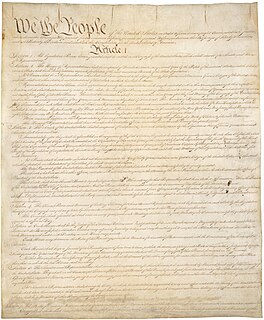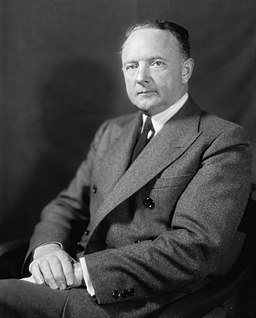Related Research Articles

The Constitution of the United States is the supreme law of the United States of America. The Constitution, originally comprising seven articles, delineates the national frame of government. Its first three articles embody the doctrine of the separation of powers, whereby the federal government is divided into three branches: the legislative, consisting of the bicameral Congress ; the executive, consisting of the president and subordinate officers ; and the judicial, consisting of the Supreme Court and other federal courts. Article IV, Article V and Article VI embody concepts of federalism, describing the rights and responsibilities of state governments, the states in relationship to the federal government, and the shared process of constitutional amendment. Article VII establishes the procedure subsequently used by the thirteen States to ratify it. It is regarded as the oldest written and codified national constitution in force.

The Seventh Amendment to the United States Constitution is part of the Bill of Rights. This amendment codifies the right to a jury trial in certain civil cases and inhibits courts from overturning a jury's findings of fact.
Massive resistance was a strategy declared by U.S. Senator Harry F. Byrd Sr. of Virginia along with his brother-in-law as the leader in the Virginia General Assembly, Democratic Delegate James M. Thomson of Alexandria, to unite white politicians and leaders in Virginia in a campaign of new state laws and policies to prevent public school desegregation, particularly after the Brown v. Board of Education Supreme Court decision in 1954. Many schools, and even an entire school system, were shut down in 1958 and 1959 in attempts to block integration, before both the Virginia Supreme Court and a special three-judge panel of Federal District judges from the Eastern District of Virginia, sitting at Norfolk, declared those policies unconstitutional.

The Civil Rights Act of 1960 is a United States federal law that established federal inspection of local voter registration polls and introduced penalties for anyone who obstructed someone's attempt to register to vote. It was designed to deal with discriminatory laws and practices in the segregated South, by which blacks and Mexican Texans had been effectively disenfranchised since the late 19th and start of the 20th century. It extended the life of the Civil Rights Commission, previously limited to two years, to oversee registration and voting practices. The act was signed into law by President Dwight D. Eisenhower and served to eliminate certain loopholes left by the Civil Rights Act of 1957.

The Constitution of the Commonwealth of Virginia is the document that defines and limits the powers of the state government and the basic rights of the citizens of the U.S. Commonwealth of Virginia. Like all other state constitutions, it is supreme over Virginia's laws and acts of government, though it may be superseded by the United States Constitution and U.S. federal law as per the Supremacy Clause.

The Byrd Machine, or Byrd Organization, was a political machine led by former Governor and U.S. Senator Harry F. Byrd (1887–1966) that dominated Virginia politics for much of the 20th century. From the 1890s until the late 1960s, the Byrd Organization effectively controlled the politics of the state through a network of courthouse cliques of local constitutional officers in most of the state's counties.

The Virginia Conventions have been the assemblies of delegates elected for the purpose of establishing constitutions of fundamental law for the Commonwealth of Virginia superior to General Assembly legislation. Their constitutions and subsequent amendments span four centuries across the territory of modern-day Virginia, West Virginia and Kentucky.

James Jackson Kilpatrick was an American newspaper journalist, columnist, author, writer and grammarian. During the 1950s and early 1960s he was editor of The Richmond News Leader in Richmond, Virginia and encouraged the Massive Resistance strategy to oppose the U.S. Supreme Court's decisions in the Brown v. Board of Education ruling which outlawed racial segregation in public schools. For three decades beginning in the mid-1960s, Kilpatrick wrote a nationally syndicated column "A Conservative View", and for years also sparred with liberals Nicholas von Hoffman and later Shana Alexander on the television news program 60 Minutes.

The Reconstruction Amendments are the Thirteenth, Fourteenth, and Fifteenth amendments to the United States Constitution, adopted between 1865 and 1870, the five years immediately following the Civil War. The last time the Constitution had been amended was with the Twelfth Amendment more than 60 years earlier in 1804. The Reconstruction amendments were a part of implementing the Reconstruction of the American South after the war. Their proponents saw them as transforming the United States from a country that was "half slave and half free" to one in which the constitutionally guaranteed "blessings of liberty" would be extended to the entire populace, including the former slaves and their descendants.
South Carolina v. Katzenbach, 383 U.S. 301 (1966), was a landmark decision of the US Supreme Court which rejected a challenge from the state of South Carolina to the preclearance provisions of the Voting Rights Act of 1965, which required that some states submit changes in election districts to the Attorney General of the United States. The preclearance provisions were ruled constitutional and the Voting Rights Act of 1965 was enforced in full.
Green v. County School Board of New Kent County, 391 U.S. 430 (1968), was an important United States Supreme Court case involving school desegregation. Specifically, the Court dealt with the freedom of choice plans created to avoid compliance with the Supreme Court's mandate in Brown II in 1955. The Court held unanimously that New Kent County's freedom of choice plan did not adequately comply with the school board's responsibility to determine a system of admission to public schools on a non-racial basis. The Supreme Court mandated that the school board must formulate new plans and steps towards realistically converting to a desegregated system. Green v. County School Board of New Kent County was a follow up of Brown v. Board of Education.
Harrison v. NAACP, 360 U.S. 167 (1959), is a 6-to-3 ruling by the Supreme Court of the United States which held that the United States District Court for the Eastern District of Virginia should have abstained from deciding the constitutionality of three barratry, champerty, and maintenance laws in the state of Virginia until state courts had had a reasonable chance to construe them.
NAACP v. Button, 371 U.S. 415 (1963), is a 6-to-3 ruling by the Supreme Court of the United States which held that the reservation of jurisdiction by a federal district court did not bar the U.S. Supreme Court from reviewing a state court's ruling, and also overturned certain laws enacted by the state of Virginia in 1956 as part of the Stanley Plan and massive resistance, as violating the First and Fourteenth Amendments to the United States Constitution. The statutes here stricken down by the Supreme Court had expanded the definitions of the traditional common law crimes of champerty and maintenance, as well as barratry, and had been targeted at the NAACP and its civil rights litigation.
The Stanley Plan was a package of 13 statutes adopted in September 1956 by the U.S. state of Virginia. The statutes were designed to ensure racial segregation would continue in that state's public schools despite the unanimous ruling of the U.S. Supreme Court in Brown v. Board of Education (1954) that school segregation was unconstitutional. The legislative program was named for Governor Thomas B. Stanley, a Democrat, who proposed the program and successfully pushed for its enactment. The Stanley plan was a critical element in the policy of "massive resistance" to the Brown ruling advocated by U.S. Senator Harry F. Byrd Sr. The plan also included measures designed to curb the Virginia state chapter of the National Association for the Advancement of Colored People (NAACP), which many Virginia segregationists believed was responsible for "stirring up" litigation to integrate the public schools.
Armistead Lloyd Boothe was a Virginia Democratic legislator representing Alexandria, Virginia: first as a delegate in the Virginia General Assembly and later as a State Senator from the newly created 36th District. A lifelong Democrat, Boothe helped lead his party's progressive faction, particularly as they opposed the Byrd Organization's policy of Massive Resistance to racial integration in Virginia's public schools.
David John Mays was an American lawyer and writer. He attempted to slow racial desegregation on behalf of Byrd Organization during the Massive Resistance era. Mays served as counsel to the Gray Commission which tried to formulate segregationists' response to the United States Supreme Court rulings in 1954 and 1955 in consolidated cases known as Brown v. Board of Education. He later unsuccessfully defended actions taken against NAACP attorneys and significantly unequal legislative reapportionment. In 2008 the University of Georgia Press published an annotated volume of excerpts of his diaries concerning the early years of Massive Resistance (1954-1959). In 1953, Mays won the Pulitzer Prize for Biography or Autobiography for Edmund Pendleton 1721-1803, a biography of the late 18th-century Virginia politician and judge Edmund Pendleton.
A.E. Dick Howard is a legal scholar who has devoted his professional life to understanding the Supreme Court, the American Constitution, and constitutions of the world. He is the White Burkett Miller Professor of Law and Public Affairs at the University of Virginia. Washingtonian magazine has named Professor Howard one of the most respected educators in the nation, and the Richmond Times-Dispatch and the Library of Virginia included Professor Howard on their list of the "greatest Virginians" of the 20th century. In 2013, the University of Virginia recognized Howard with its Thomas Jefferson Award—the highest honor given to faculty members at the University.
The Commission on Public Education, known as the VPEC or Gray Commission, was a 32-member commission established by Governor of Virginia Thomas B. Stanley on August 23, 1954 to study the effects of the U.S. Supreme Court decisions in Brown v. Board of Education issued on May 17, 1954 and May 31, 1955, and to make recommendations. Its counsel were David J. Mays and his associate Henry T. Wickham.

Government by Judiciary is a 1977 book by constitutional scholar and law professor Raoul Berger which argues that the U.S. Supreme Court has interpreted the Fourteenth Amendment of the U.S. Constitution contrary to the original intent of the framers of this Amendment and that the U.S. Supreme Court has thus usurped the authority of the American people to govern themselves and decide their own destiny. Berger argues that the U.S. Supreme Court is not actually empowered to rewrite the U.S. Constitution--including under the guise of interpretation--and that thus the U.S. Supreme Court has consistently overstepped its designated authority when it used its powers of interpretation to de facto rewrite the U.S. Constitution in order to reshape it more to its own liking.
References
- ↑ Sweeney, James (2013). "Postscript to Massive Resistance: The Decline and Fall of the Virginia Commission on Constitutional Government". The Virginia Magazine of History and Biography. 121, no. 1: 45.
- ↑ James R. Sweeney ed., Race, Reason, and Massive Resistance The Diary of David J. Mays, 1954–1959 (2008).
- ↑ Sweeney, James (2013). "Postscript to Massive Resistance: The Decline and Fall of the Virginia Commission on Constitutional Government". The Virginia Magazine of History and Biography. 121, no. 1: 50–51.
- ↑ Virginia. Commission on Constitutional Government. (4 June 1964). "Civil rights and Federal powers : a further critical commentary upon the pending omnibus Civil rights bill" (PDF). Richmond, Va. : The Commission. Retrieved 19 September 2019.
- ↑ Virginia. Commission on Constitutional Government. (4 June 1963). "Civil rights and legal wrongs : a critical commentary upon the President's pending "Civil rights" bill of 1963". Richmond, Va. : The Commission – via Internet Archive.
- ↑ Virginia Commission on Constitutional Government (1964). Right Not To Listen.
- ↑ Virginia. Commission on Constitutional Government. (4 June 1960). "Did the court interpret or amend? The meaning of the Fourteenth amendment, in terms of a State's power to operate racially separate public schools, as". [Richmond, 1960] – via Internet Archive.